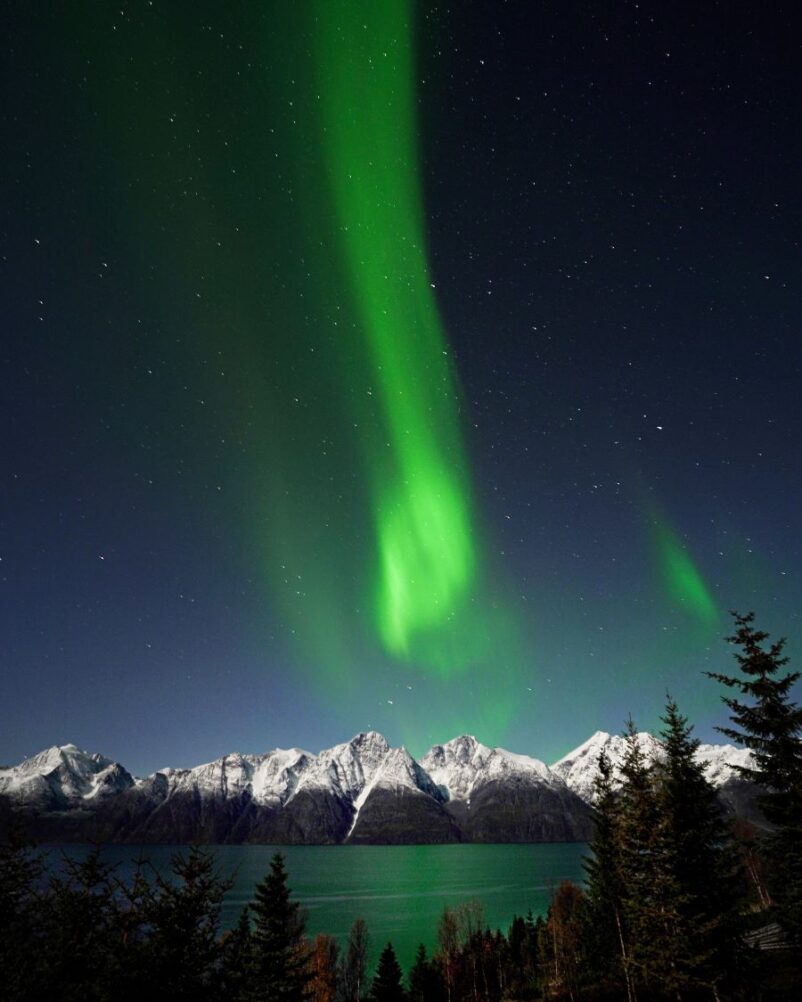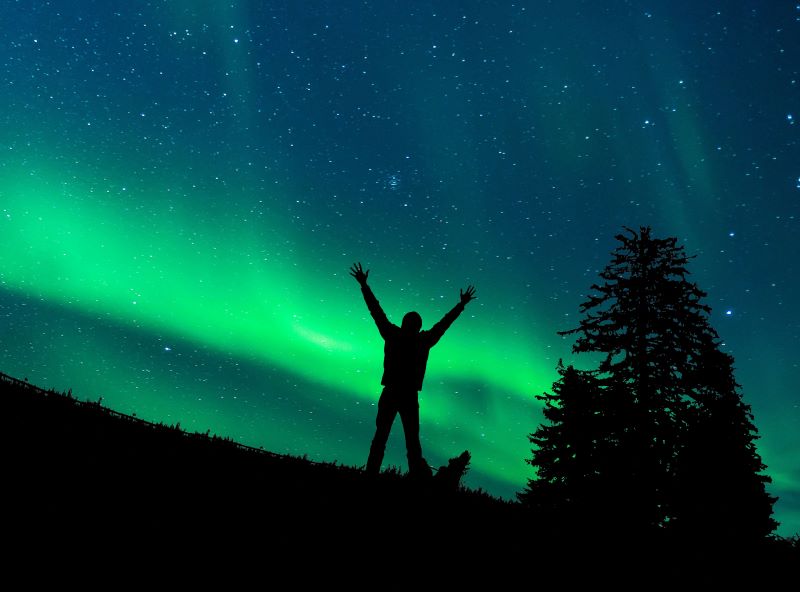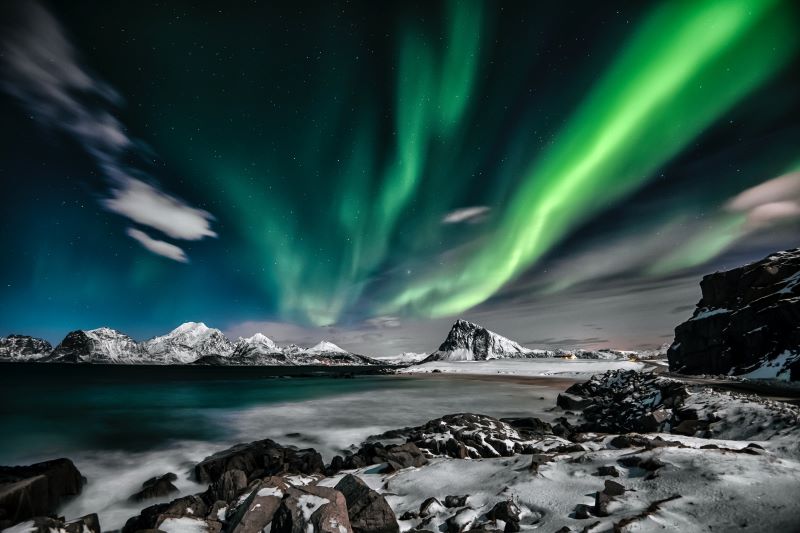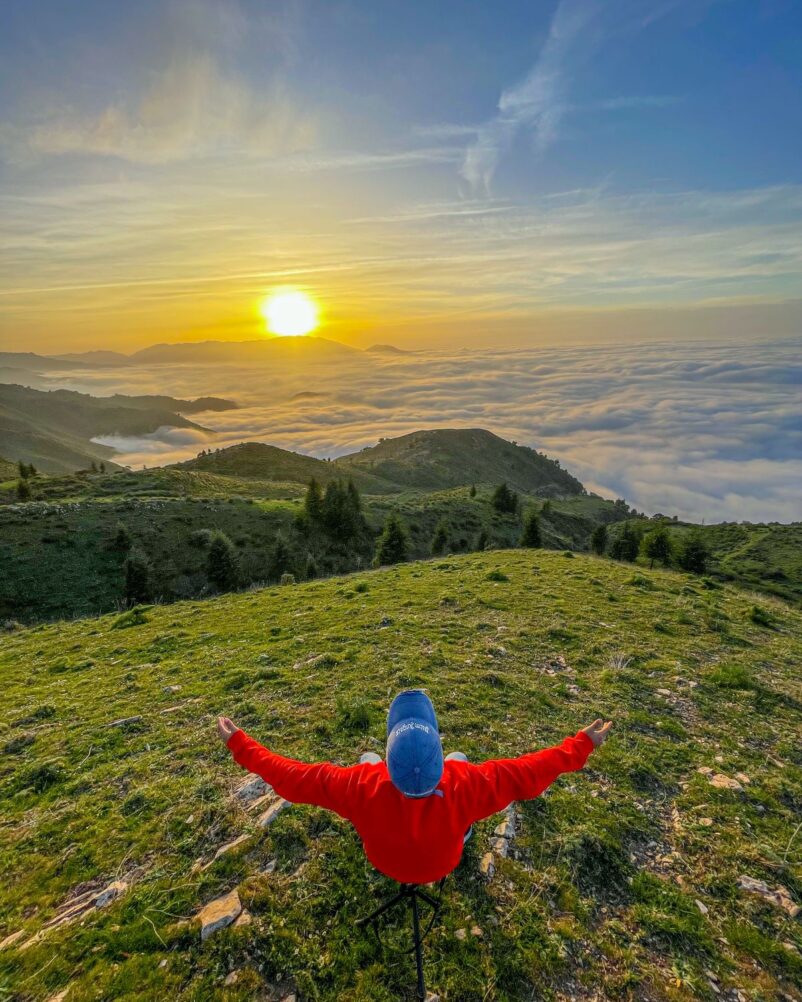
Are you ready to witness the breathtaking dance of colors in the night sky? Get your cameras and warmest jackets ready because the northern lights forecast is that auroras are about to become more noticeable and common than in recent years!
Scientists with the Solar Cycle 25 Prediction Panel have recently made a groundbreaking discovery that is sending waves of excitement through the aurora-chasing community. According to their northern lights forecast, solar activity is set to reach an unprecedented peak over the last 20-30 years, resulting in intensified displays of the northern lights until fall 2024.
So, if you’ve always dreamed of experiencing this natural wonder firsthand or capturing it on film, the current northern lights forecast says that now is your chance. Get ready for an awe-inspiring adventure under the celestial canvas.
The Beauty and Mystery of the Northern Lights
Having the opportunity to stand beneath the vast night sky, witnessing streaks of vibrant colors dancing across the darkness, is a dream come true for many people. After all, it is impossible to deny the enchantment of the northern lights. These ethereal displays of celestial magic have captivated humans for centuries, inspiring myths and legends across cultures.
What makes them even more captivating is their elusive nature – they appear as if summoned by invisible forces, painting the canvas of darkness with hues that range from pale greens to shimmering purples. Despite our scientific understanding of their origins in solar particles colliding with Earth’s atmosphere, there remains a sense of mystery and awe whenever these lights grace our presence.
One can only truly appreciate the beauty and mystery of the northern lights by venturing into areas where they occur frequently, such as Alaska, or Scandinavia’s northern regions. Here, amidst serene landscapes untouched by human intervention, one can immerse themselves in nature’s grand spectacle.
Standing beneath an open sky ablaze with colorful hues creates a deep connection between oneself and the universe. It serves as a reminder that we are mere inhabitants on this planet, fortunate enough to witness cosmic artwork beyond our comprehension.
As technology advances and our understanding grows, predicting through an improved northern lights forecast of when and where these captivating spectacles will occur becomes increasingly possible.
The emergence of an accurate northern lights forecast enables enthusiasts to plan their trips accordingly – increasing their chances of witnessing this natural phenomenon firsthand. Not only does this provide hope and excitement among those hoping to glimpse this wonder for themselves but also encourages more individuals to venture into remote corners of the world.
That’s great news for seekers of the northern nights experience, which includes the like of Rick and me, as it is on our bucket list.
Understanding the Science Behind the Phenomenon
 The phenomenon of the northern lights, known as the Aurora Borealis, has captivated and mystified humans for centuries. But what exactly causes this dazzling display of lights in the sky?
The phenomenon of the northern lights, known as the Aurora Borealis, has captivated and mystified humans for centuries. But what exactly causes this dazzling display of lights in the sky?
The science behind it is quite fascinating. It all starts with charged particles from the sun, known as solar wind, which are carried toward Earth by magnetic fields. When these particles collide with atoms and molecules in our atmosphere, they release energy in the form of light.
But why do we see different colors during a northern lights display? That is because each color represents a specific gas that is being energized by the solar particles. Oxygen emits colors such as green and red, while nitrogen can produce blue and purple hues.
The intensity and variety of colors visible depend on factors like altitude and density of gases in our atmosphere at any given time. The most common colors are pale yellow and green made up from oxygen molecules, while it is less common to see the red and purple auroras.
The color palette isn’t something that is part of a northern lights forecast, but since each display is an original, dancing canvas, that is okay!
So when you witness a mesmerizing array of colors dancing across the night sky, remember that it’s all thanks to interactions between magnetic fields, solar particles, and our own planet’s atmosphere.
Northern Lights Forecast: Factors that Affect Visibility
One of the primary factors that affect visibility of the northern lights is solar activity. This natural phenomenon occurs when there is an increase in solar wind from the Sun, which causes charged particles to collide with atoms in the Earth’s atmosphere, resulting in beautiful displays of light.
When solar activity is high, with more sunspots and solar flares, there is a greater chance for stronger and more vibrant auroras to occur. Conversely, during periods of low solar activity, such as during a solar minimum, the northern lights may be less visible or even non-existent.
Another crucial factor influencing visibility via a northern lights forecast is weather conditions. Clear skies are essential for optimal viewing opportunities as any cloud cover will obstruct your view of this mesmerizing display. The ideal scenario would be a clear night with little to no light pollution from surrounding cities or towns.
Light pollution not only hinders your ability to spot the auroras but also affects their apparent intensity and color clarity. Therefore, finding locations away from artificial light sources can greatly enhance your chances of witnessing this breathtaking spectacle.
In addition to these external factors affecting visibility and viewability, personal readiness also plays a significant role in experiencing these celestial wonders. Staying up late at night or waking up early before dawn increases your chances of witnessing this remarkable event as it typically appears between 10 p.m. and 2 a.m. local time during peak seasons like winter months or near equinoxes. By being prepared with warm clothing, appropriate camera equipment for capturing long-exposure photos, and knowing where to look, your chances of witnessing the auroras is better now than it has been in quite a while.
Advancements in Technology for Northern Lights Forecast Accuracy
Advancements in technology have revolutionized the way we predict and experience the mesmerizing beauty of the aurora. In the past, relying solely on weather reports and luck made it difficult to catch a glimpse of this natural phenomenon. However, with the integration of cutting-edge tools and data analysis techniques, a northern lights forecast has become more accurate than ever before.
One new innovation is real-time satellite imagery that captures the intensity and movement of solar flares. Solar flares are responsible for creating the charged particles that interact with Earth’s magnetic field to produce auroras. By analyzing these live images from various satellites, scientists can now predict when and where intense solar activity will occur, providing us with a more precise forecast of potential northern lights displays.
Another breakthrough technology that plays a crucial role in the northern lights forecast prediction is geomagnetic monitoring stations spread across different regions. These stations constantly measure changes in Earth’s magnetic field, as disturbances in this field indicate an increased likelihood of seeing auroras. With advanced algorithms and machine learning capabilities, these monitoring systems can process vast amounts of data collected from diverse sources to calculate accurate predictions for when and where northern lights will occur.
Thanks to these advancements in technology, our chances of witnessing the awe-inspiring dance of colors in the sky have significantly improved. As researchers continue refining their models and utilizing emerging technologies like artificial intelligence, we can look forward to even more precise predictions that allow us to plan unforgettable trips under nature’s most stunning light show – the captivating northern lights.
While there are many websites and organizations that monitor the sun and provide a forecast, a highly recommended one is the US National Oceanic and Atmospheric Administration site.
Northern Lights Forecast: Best Times and Locations
One of the best times to witness the captivating spectacle of the northern ights is during the winter months. This is because the nights are longer, allowing for more opportunity to see this natural phenomenon. Additionally, arctic regions such as Scandinavia, Iceland, and Alaska provide some of the most ideal locations to spot the lights due to their proximity to the Earth’s magnetic poles.
However, it’s important to note that even within these regions, there are specific locations that offer better chances of witnessing a stunning display. For example, in Norway, Tromso and Svalbard are known for their clear skies and minimal light pollution, making them ideal spots for viewing the Northern Lights.
In Iceland, areas like Reykjanes Peninsula and Thingvellir National Park provide breathtaking backdrops against which these dancing lights can be observed.
Another factor that plays a significant role in spotting this ethereal show is timing. The months between September and March tend to have higher occurrences of auroras due to increased geomagnetic activity during this time. Furthermore, while late evenings and early mornings may be conducive for spotting on certain days, aiming for around midnight often presents optimal conditions as solar winds reach their peak intensity.
If you’re seeking the best chance for an unforgettable experience watching nature’s enchanting light display of the Aurora Borealis – it’s best to plan your trip during winter months in prime locations. Remember too that choosing specific destinations within these regions where skies are typically clear will increase your odds.
However, the northern lights can sometimes be seen in other areas beyond Fairbanks, Alaska, in the United States not typically known for the displays. Lights have recently been reported in Minnesota and even Pennsylvania, and additional surprise locations are projected up until fall 2024 as conditions allow.
Tips for Capturing Stunning Photographs of the Aurora Borealis
- Timing is everything. To capture stunning photographs of the Aurora Borealis, it’s important to plan your trip during peak activity periods. Check the northern lights forecast and select a location away from city lights for optimal viewing conditions.
Remember that patience is key, as the auroras can sometimes be elusive and only appear for short intervals. It’s also beneficial to learn about the duration and frequency of solar storms, which are responsible for generating these captivating light displays. - Choose the right equipment. A good camera is essential for capturing clear and detailed images of the Northern Lights. Invest in a DSLR or mirrorless camera with manual settings capabilities to adjust your exposure time, aperture, and ISO accordingly.
Wide-angle lenses are ideal for capturing expansive shots of the sky, while tripod stability will minimize blurry images caused by shaky hands. Utilize remote shutter releases or timers to prevent shake when pressing down on the shutter button. - Experiment with different techniques. Don’t be afraid to explore various creative techniques to make your Aurora Borealis photographs stand out from others. Try using long exposures to capture vibrant colors and mesmerizing light trails across the sky.
Play around with different compositions by including interesting foreground elements such as rock formations or trees to add depth and context to your images. And don’t forget about post-processing! Editing software like Adobe Lightroom can help enhance contrast, saturation, and overall image quality.
Northern Lights Forecast: Embracing Nature’s Wondrous Light Show
 Embracing the wonder of the Aurora Borealis is an experience that can truly captivate the soul. Standing beneath a sky ablaze with shimmering hues of green and purple, one cannot help but feel a profound connection to something greater than ourselves. The awe-inspiring beauty of this natural phenomenon reminds us of the extraordinary wonders that exist in our world and serves as a reminder to appreciate and protect the delicate balance of nature.
Embracing the wonder of the Aurora Borealis is an experience that can truly captivate the soul. Standing beneath a sky ablaze with shimmering hues of green and purple, one cannot help but feel a profound connection to something greater than ourselves. The awe-inspiring beauty of this natural phenomenon reminds us of the extraordinary wonders that exist in our world and serves as a reminder to appreciate and protect the delicate balance of nature.
Observing the northern lights also allows us to tap into our own sense of curiosity and wonder. It encourages us to venture outside our comfort zones and explore new horizons, both literally and metaphorically. As we stand in awe before these dancing lights, we are reminded that there is so much more to discover beyond what we know – both in terms of the universe around us and within ourselves.
Embracing the wonder of the northern lights is an invitation to pause, reflect, and find solace in the magnificence of nature. It fosters a deeper appreciation for the magic that exists all around us and ignites a sense of adventure within. So let go of your worries, open your heart to awe-inspiring beauty, and if you have successfully tracked a northern lights forecast and are lucky enough to see this spectacle, let yourself be carried away by these celestial wonders.
Northern Lights Forecast: Catching the Elusive Dancing Light Show
While Rick and I are still seeking the opportunity to capture the magic, two of three our children have witnessed them in all their glory while living in Alaska.
Our youngest recently traveled to Iceland and had hoped to see them, and even used a local northern lights forecast to increase the odds, but they dodged his view the entire week, although reports show they were in fine form the following week. That’s the issue of planning an entire trip around the quest to behold them.
With this new report of a northern lights forecast of greatly increased odds of seeing them, we’re talking about making a trek to Fairbanks in 2024 for what we hope becomes another thing we can strike off our long and glorious bucket list!
If you liked this article, check out more travel blogs from Senior Denial:
- Travel to Europe Requires a New Approval in 2024
- How Passport Processing Delays are Grounding Big Travel Dreams
- 7 Senior Travel Musts for Trips with Extensive Walking
- The Truth About Senior Rewards Programs: Do They Pay Off?
- Escape A Boring Life After Retirement: Unleash Your Inner Adventure
Written by
Robin McClure
Robin is the author of 7 parenting books and has 3 grown children, 3 spoiled rescue dogs, and a very understanding husband. She holds a bachelor's degree in journalism and a master's degree in communications, and spends her time writing, drinking coffee, and planning the next grand adventure.



